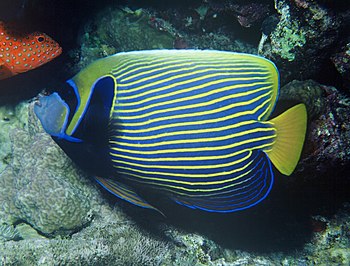 |
| An emperor angelfish (Photo credit: Wikipedia) |
One of the most distinctively colored marine angelfish, it has bright yellow horizontal lines on its blue body, while a black band lined with neon blue covers its face. Its tail is either yellow or orange. Juvenile Emperor angelfish are no less stunning. Their deep blue body is filled with electric blue and white concentric circles.
The Emperor angelfish is commonly found throughout the Indo-Pacific ocean, the Red Sea and even the Great Barrier Reefs in Australia.
As juveniles, they provide cleaning services to other fish in the wild. They will constantly pick at any parasites it may find on the bodies of other fish.
A pricey fish, juveniles are priced from $60 to $80 USD while very large "show quality" adults can fetch up to $400 USD.
Most species within the genus Pomacanthus are bully's in one form or another. The emperor angelfish is aggressive towards other large angels and is very hostile towards members of the same species.
Fishes from outside the Pomacanthidae family are generally left alone. It might bully large tangs, butterfly fish, and even larger wrasses but in general, other species are ignored.
The emperor angelfish attain lengths of up to 16 inches in the wild. That translates into lengths of up to 10 to 11 inches in an aquarium as angelfish rarely achieve their full length in captivity. At that length, it is still a big fish that needs larger aquariums to really do well. 150 gallons should be the bare minimum and a 200 gallon or larger tank is highly recommended.
Caves and overhangs really only work with larger tanks, most opt for an "open" scape when housing large angels such as the Emperor Angelfish. They require a large amount of swimming space.
The Emperor Angelfish is not considered reef safe. Though you may sometimes see them housed in reef aquariums, they're generally better suited to fish-only aquariums. This is because their diets in the wild include corals, sponges, tunicates, and algae.
They should be offered a good variety of foods from algae-based foods like nori/seaweed as well as meaty foods like krill and mysis shrimp.
A balanced food that is pretty good for your Emperor Angelfish is Formula Two. It contains a mix of seafood and an extra portion of algae for herbivorous fish. It is available in three forms, flake, pellet and frozen. If you're going for a good pellet food, I suggest trying the highly reputable New Life Spectrum instead.
The most complete food available for all large angelfish is Angel Formula by Ocean Nutrition. This food was developed with large angelfish in mind, they contain fresh seafood, vitamins, marine sponges and fresh algae. Unfortunately, Angel Formula is only offered in frozen form.
They should be given ample amounts of algae. You can choose either seaweed sheets from companies catering to angelfish or you can get nori sheets sold as sushi wrappers at your local supermarket.
Make sure you buy unflavored/unspiced nori when shopping at the supermarket. Just get the regular, plain nori. Raw nori would be even better. Attach the seaweed/nori to a clip and stick in onto the side of the aquarium.
For guides containing lots of photos and videos on the Emperor Angelfish and the Queen Angelfish please drop by my Hubpages site, thanks. Article Source: EzineArticles |





